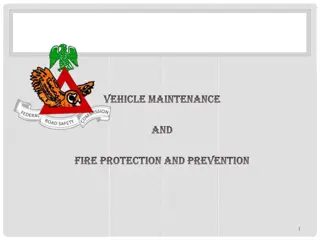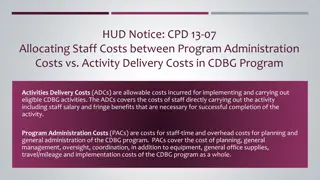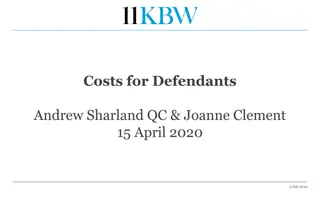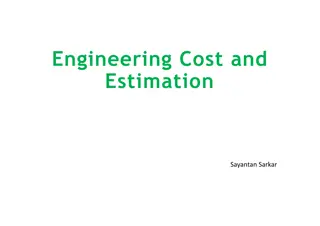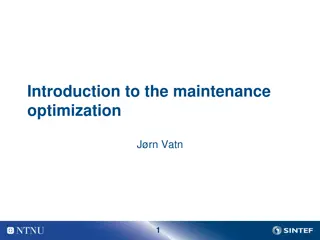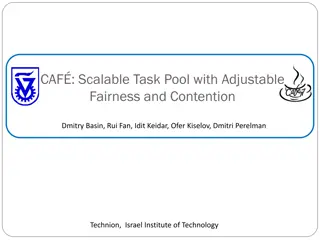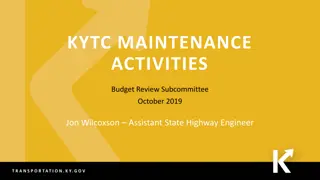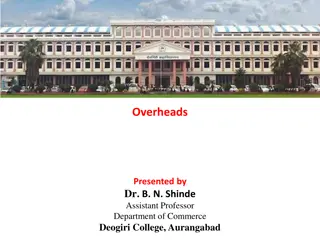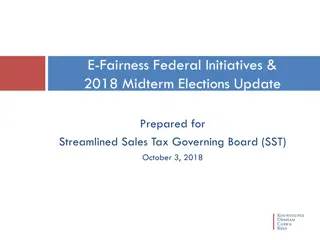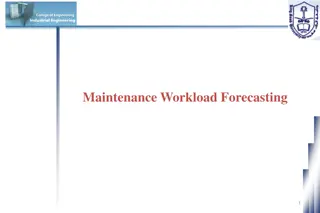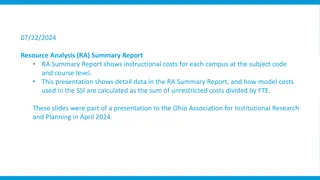Tactically Using New Costs Rules for Fairness in Maintenance
The application of new costs rules in maintenance cases, considering fairness and sharing between parties. Analyzing cases where conduct influences costs orders, particularly in regards to financial impact on the parties. Examples from recent legal cases highlight the importance of reasonable negotiation and responsible litigation to avoid disproportionate cost outcomes.
Download Presentation

Please find below an Image/Link to download the presentation.
The content on the website is provided AS IS for your information and personal use only. It may not be sold, licensed, or shared on other websites without obtaining consent from the author.If you encounter any issues during the download, it is possible that the publisher has removed the file from their server.
You are allowed to download the files provided on this website for personal or commercial use, subject to the condition that they are used lawfully. All files are the property of their respective owners.
The content on the website is provided AS IS for your information and personal use only. It may not be sold, licensed, or shared on other websites without obtaining consent from the author.
E N D
Presentation Transcript
Tactically using the new costs rules and Fairness and sharing- where are we with maintenance? Alexis Campbell QC May 2020
No order as to costs, unless justified by a parties conduct FPR 2010, SI 2010/2955, 28.3(6) and (7) Having regard to: any failure by a party to comply with FPR 2010, any order of the court or any relevant practice direction any open offer to settle made by a party whether it was reasonable for a party to raise, pursue or contest a particular allegation or issue the manner in which a party has pursued or responded to the application or a particular allegation or issue any other aspect of a party s conduct in relation to proceedings which the court considers relevant, and the financial effect on the parties of any costs order 1. 2. 3. 4. 5. 6.
FPR 2010, PD 28A, para 4.4 The court will take a broad view of conduct for the purposes of this rule and will generally conclude that to refuse openly to negotiate reasonably and responsibly will amount to conduct in respect of which the court will consider making an order for costs. This includes in a needs case where the applicant litigates unreasonably resulting in the costs incurred by each party becoming disproportionate to the award made by the court. Where an order for costs is made at an interim stage the court will not usually allow any resulting liability to be reckoned as a debt in the computation of the assets.
WG v HG [2018] EWFC 84 In a case where all the wealth was pre-acquired, with no marital acquest, Francis J found that the wife s claim was limited to her needs, and she had been wrong to pursue a case in excess of this (and in excess of more than 50% of the H s wealth). The wife had suffered a serious accident towards the end of that marriage which led to her needing life-long care costs. Her legal fees (and loans) amounted to 915k. Without an order to cover her costs, the wife would have to eat into her needs award, diminishing either her housing budget or her income and care budget.
WG v HG [2018] EWFC 84 people could not litigate on the basis that they would be bound to be reimbursed for their costs and no one ought to enter litigation expecting a blank cheque.. The wife was awarded a sum of 400,000 towards her outstanding fees of 915,000, thereby forcing her to eat into her Duxbury fund by 500,000.
MB v EB [2019] EWHC 3676 Cohen J made specific reference to FPR 2010, PD 28A, para 4.4 (at para [33]), and described the parties costs (collectively 1.25m) as grossly disproportionate to what was in issue and made reference to the husband s lack of response to an offer of settlement made by the wife, saying (at para [34]): I find that the wife s offer was light, but I am in no doubt that, if there had been a sensible (or any) response, there would have been a quick resolution of this case. This case has been conducted by the husband in a manner that I find to be irresponsible and unreasonable. H had spent 650k on costs. He was awarded 325,000 (Duxbury fund) and W was ordered to meet 125,000 of the outstanding bill of 380,000 costs. H would have to make up the 230,000 shortfall from his Duxbury fund.
SCHEDULE OF ISSUES Opportunity to identify the issues. Require parties to pin their colours to the mast. Issues which are fought and lost may have cost consequences. In advance of FDA Directions orders record recitals about agreements and disputes On open offers, set out basis of offer In advance of final hearing, requirement to set out schedule of issues be specific
Fairness and sharing Where are we with maintenance?
WAGGOTT v WAGGOTT [2018] EWCA 727 Equal sharing Long marriage H s net income 3-4m Net assets 16.4m
Capital share 9.76m Free capital 4.6m W s income needs 175k pa Free capital 4.6m x 2.25% (net investment return) 100k pa Income shortfall 75k Met by non-extendable term order H to pay W till 52 75k x 5 years W to pay for 8 years between 52 and retirement at 60 8 x 75k = 600k Pension at 60 produces net income 50k pa Shortfall from pension age on Duxbury 25k = 360k % W s capital used to meet income needs ( 960k/ 9.76m) c.10%
C v C [2018] EWHC 3186 (Roberts J) Equal sharing 10 year marriage Net assets 27m H s net income 3-4m
C v C - Order Capital share 10.2m Free capital now 5m Later free capital (after downsizing) 6.5m Income needs 157k Income from free capital 112.5k Income shortfall to pension ( 44.5k x 15) 668k Income shortfall after pension draw ( 10.75k x life) 81k % W capital used to meet needs ( 668k+ 81k/ 10.2m) 7%
ODwyer v ODwyer [2019] EWHC 1838 (Francis J) (Francis J) Marriage 28 years Net assets = 6m McDonalds franchise producing income for H at 1m pa
Net capital to W 3m Free capital 1.73m Income needs 68k pa 1.73m x 3.75% (gross) 52k net pa Income needs ( 68k - 52k) 16k 4 year non-extendable term order (4 x 68k) 272k (by H) Duxbury fund to provide 68k from retirement 965k % W s capital to meet income needs ( 965k/ 3m) 32%
CB v KB [2019] EWFC 78 (Mostyn J) Long marriage Net capital 10.22m H s net income 400k - 1.4m
Net capital to W 5.1m W s free capital now 2.1m Free capital after downsizing at 60 3.6m 100% free capital applied to Duxbury fund 3.6m Duxbury fund provides net income to age 60 172k Income after 60 for rest of (actuarial) life 115k % W s capital to meet income needs ( 3.6m/ 5.1m) 71%
Analysis Name Waggott v Waggott [2018] EWCA 727 Moylan LJ C v C O'Dwyer v O'Dwyer [2019] EWHC 1838 Francis J 28 years 62 60 4 x adults CB v KB [2018] EWHC 3186 Roberts J [2019] EWFC 78 Mostyn J Marital relationship H's age W's age Age of children 21 years 53 47 14 10 years 45 45 9 & 6 19 years 41 45 6 (aged 7 - 20) Net capital H's net income W's net income (capacity) W's share of capital Free capital Maintenance Award Term periodical payments 16.4m 3-4m Ignored 9.76m 4.6m 27m 3-4m Potential but unspecified 10.2m 5m 6m 1m None 3m 1.733m 10.22m ( incl income stream) 400k - 1.4m net 22,500 net pa 5.1m 2.15m - 3.6m 5 x 75,000 To age 52 375,000None 4 x 68,000 H's retirement at 66 272,000None Additional Maintenance needs: W's income needs Net income from free capital (2.25%) 100,000 pa Income shortfall W's age at end of term Retirement age Needs to retirement Additional capital Pension provision at 60 Total net income after retirement Shortfall from pension income Duxbury LS to meet needs W s capital used to meet income needs 175,000 pa 157,000 112,500 pa 44,500 pa 120,000 pa 52,000 pa 68,000 pa 64 64 222,000 pa 172,000 pa 50,000 pa 75,000 pa 52 60 8 x 75,000 n/a 50,000 pa 150,000 pa 25,000 pa 25,000 pa 60 60 50k payable as Child Support 1.5m from downsizing Joint lives Duxbury Joint lives Duxbury Joint lives Duxbury 600,00015 x 44,500 1.5m from downsizing 33,750 pa 146,250 pa 10,750 pa 360,000 10,750 pa 667,500 81,186 68,000 pa 965,000 3.6m c. 10% 960,000 c. 7% 748,686 c. 32% 965,00071% 3,600,000
ALEXIS CAMPBELL QC May 2020


